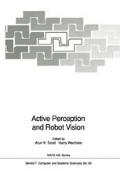Abstract
Motion vision and pictorial vision are considered to be fairly separate abilities. In the development of biological species on our planet, motion vision is assumed to be phylogenetically older. Also in the development of human infants, motion vision precedes the capability of pictorial vision as psychologists have found out [Yonas 83]. In computer vision, the development went in the opposite direction. The study of static scenes was the starting point for most of the research into vision. This may be attributable to the fact that the interpretation of a static image seems to be easier than dealing with motion. However, when the task is motion understanding the best starting point probably is not the platform developed for static image processing but a basically different one taking a fresh unbiased view on the different type of problem.
Access this chapter
Tax calculation will be finalised at checkout
Purchases are for personal use only
Preview
Unable to display preview. Download preview PDF.
7 Literature
E.D. Dickmanns: Dynamic Computer Vision for Mobile Robot Control. Proc. of 19-th Intern. Symposium and Exposition on Robots, Sydney, Australia, Nov. 1988.
E.D. Dickmanns, V. Graefe: a) Dynamic monocular machine vision. Machine Vision and Applications, Vol. 1, Springer International, 1988. pp 223–240. b) Applications of dynamic monocular machine vision (ibid), pp 241–261.
E.D. Dickmanns, A. Zapp: A Curvature-based Scheme for Improving Road Vehicle Guidance by Computer Vision. SPIE Conf. 727 on “Mobile Robots”, Cambridge, Mass., USA, Oct. 1986.
E.D. Diekmanns, A. Zapp: Autonomous High Speed Road Vehicle Guidance by Computer Vision. Preprint, Vol. 4, IFAC-Congress 1987, Munich, pp 232–237.
G. Eberl: Automatischer Landeanflug durch Rechnersehen. Diss., Fakultät für Luft- und Raumfahrttechnik der Universität der Bundeswehr München, Juli 1987.
V. Graefe: Two Multi-Processorsystem for Low-Level Real-Time Vision. In: J.M. Brady, L.A. Gerhardt and H.F. Davidson (eds) Robotics and Artificial Intelligence. Springer, 1984, pp 301–308.
V. Graefe, U. Solder: Detection of Objects in the Path of a Vision Guided Mobile Robot. Intern. Advanced Robotics Programme - Second Workshop on Manipulators, Sensors and Steps towards Mobility, Manchester, Nov. 1988.
G. Haas: Meßwertgewinnung durch Echtzeitauswertung von Bildfolgen. Diss., Fakultät für Luft- und Raumfahrttechnik der Universität der Bundeswehr München, 1982.
K.D. Kuhnert: Zur Echtzeit-Bildfolgenanalyse mit Vorwissen. Diss., Fakultät für Luft- und Raumfahrttechnik der Universität der Bundeswehr München, 1988.
P.S. Maybeck: Stochastic models, estimation and control. Vol. 1, Acad. Press, 1979.
H.G. Meissner: Steuerung dynamischer Systeme aufgrund bildhafter Informationen. Diss., Fakultät für Luft- und Raumfahrttechnik der Universität der Bundeswehr München, 1982.
B. Mysliwetz, E.D. Dickmanns: Distributed scene analysis for autonomous road vehicle guidance. Proc. SPIE Conf. on Mobile Robots Vol 852, Cambridge, USA, Nov. 1987.
K.R. Popper, J.C. Eccles: The Self and Its Brain - An Argument for Interactionism. Springer Internat., Berlin, 1977.
A. Schopenhauer: Die Welt als Wille und Vorstellung. In: W. Löhneysen (ed) Arthur Schopenhauer, Sämtliche Werke. Suhrkamp, Frankfurt a.M., (Nachdruck 1986).
H.J. Wünsche: Detection and Control of Mobile Robot Motion by Real-Time Computer Vision. SPIE Conf. 727 on Mobile Robots, Cambridge, Mass., Oct. 1986, pp 100–109.
H.J. Wünsche: Bewegungsteuerung durch Rechnersehen. Fachberichte Messen, Steuern, Regeln Bd. 20, Springer-Verlag, Berlin, 1988, 201 Seiten.
A. Yonas: Development Stages of Depth Perception in Human Infants. In: D. Ingle et al. (eds): Brain Mechanisms and Spatial Vision, NATO-ASI, Lyon 1983, Springer-Verlag.
A. Zapp: Automatische Straßenfahrzeugführung durch Rechnersehen. Diss., Fakultät für Luft- und Raumfahrttechnik der Universität der Bundeswehr München, 1988.
Author information
Authors and Affiliations
Editor information
Editors and Affiliations
Rights and permissions
Copyright information
© 1992 Springer-Verlag Berlin Heidelberg
About this paper
Cite this paper
Dickmanns, E.D. (1992). Active Vision Through Prediction-Error Minimization. In: Sood, A.K., Wechsler, H. (eds) Active Perception and Robot Vision. NATO ASI Series, vol 83. Springer, Berlin, Heidelberg. https://doi.org/10.1007/978-3-642-77225-2_4
Download citation
DOI: https://doi.org/10.1007/978-3-642-77225-2_4
Publisher Name: Springer, Berlin, Heidelberg
Print ISBN: 978-3-642-77227-6
Online ISBN: 978-3-642-77225-2
eBook Packages: Springer Book Archive

